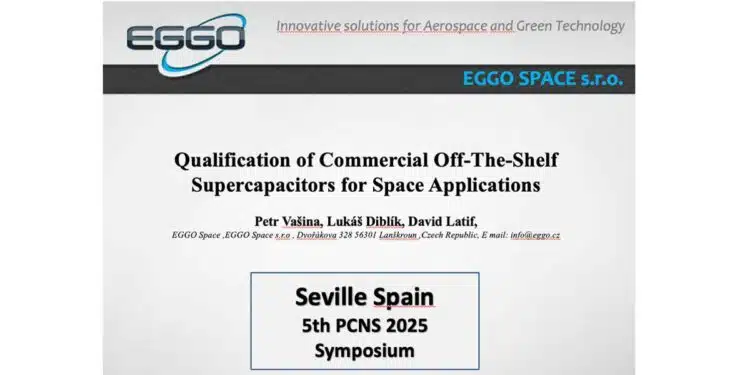The paper “Qualification of Commercial Off-The-Shelf Supercapacitors for Space Applications” was presented by David Latif, EGGO Space s.r.o , Lanskroun, Czech Republic at the 5th PCNS Passive Components Networking Symposium 9-12th September 2025, Seville, Spain as paper No. 6.1.
Introduction
The article “Qualification of Commercial Off-The-Shelf Supercapacitors for Space Applications” by Petr Vašina, Lukáš Diblík, and David Latif from EGGO Space s.r.o, focuses on the evaluation of large format supercapacitors for potential use in space applications.
Supercapacitors, also known as electrochemical double layer capacitors, are energy storage devices that store electric energy in the double layer between a high surface area electrode and an electrolyte.
Unlike batteries, they do not involve chemical reactions at the electrodes, making them suitable for various applications, including spacecraft and launchers.
Key Points
- The study involves comparative tests of supercapacitors from different suppliers, conducted according to IEC 62391 standard methods.
- Supplier 1’s supercapacitors demonstrated superior power performance due to significantly lower Equivalent Series Resistance (ESR) compared to competitors.
- The research highlights the impact of ESR on efficiency, capacitor temperature performance, and lifespan at different loads.
Extended Summary
The article presents a detailed analysis of supercapacitors, focusing on their potential for space applications. EGGO Space s.r.o conducted comprehensive tests on large format supercapacitors, comparing products from more manufacturers.
The tests were performed using IEC 62391 standard methods, ensuring high-quality results with 10 units tested for each product. The findings revealed that Supplier 1’s supercapacitors exhibited exemplary power performance, primarily due to their lower ESR compared to competitors. The ESR of the best competing product was found to be twice as high, with many others nearly three times higher.
The study also contextualizes the test results by examining the effects of ESR on various performance metrics, such as efficiency, capacitor temperature performance, and lifespan, under different load conditions. These factors are crucial for determining the suitability of supercapacitors for space applications, where reliability and efficiency are paramount.
Conclusion
The research concludes that high capacitance ultracapacitors hold significant potential for various applications, including the space sector. However, testing these cells requires precise hardware facilities and software connections tailored to individual customer prototypes or commercial products. EGGO Space Testhouse, with its extensive experience and well-equipped laboratory, is positioned as a potential lab for the qualification of such ultracapacitors, offering valuable expertise and resources for future developments in this field.






























